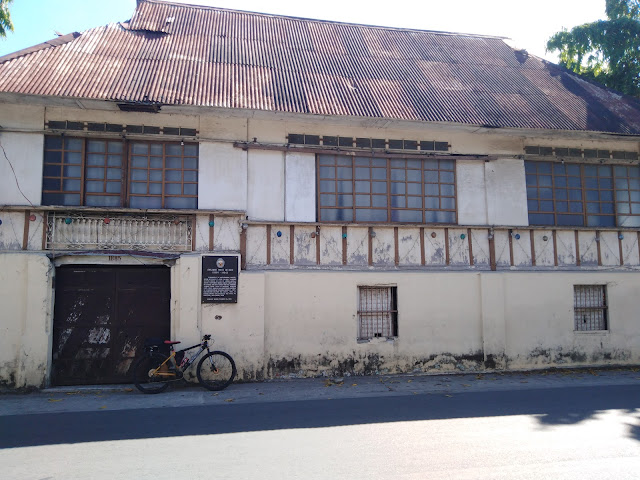 |
| 'Stone carving of religious figures at the Inukit Site in Maragondon, Cavite' |
Last February 7, 2021, I went on an unforgettable bike ride from Imus to the quiet and historical town of Maragondon, Cavite. It was a long but rewarding journey—around 110 kilometers in total balikan ang layo, pero sulit ang pagod dahil sa ganda at katahimikan ng lugar. I had 3 trips in Maragondon, two of them a group ride and the other one a solo ride.
There is a view of remembering entering the welcome arch of Maragondon. Bumungad agad sa amin ang tanawin ng mga bundok sa malayo. It was breathtaking. The crisp air and peaceful surroundings were a welcome change from the busy streets of Imus. Maaga pa noon at hindi pa gaanong nakakapaso ang sikat ng araw. Parang bumalik kami sa ibang panahon—tahimik, presko, at puno ng kasaysayan.
Maragondon is a town rich in history and culture. Dito mo makikita ang mga ancestral houses na itinayo pa noong panahon ng Kastila. As you roam the town, you’ll feel the deep connection of the locals to their heritage. The Bonifacio Trial House, for instance, is a historical landmark where Andres Bonifacio was tried before his execution.
Speaking of Bonifacio, isa sa mga highlight ng aming ride ay ang pag-akyat sa Mount Buntis. Medyo challenging ang ruta pero sobrang worth it. Maraming matarik na bahagi at may mahabang trail kaming dinaanan bago namin mapuntahan ang tuktok ng bundok, dito makikita ang execution site ni Andres Bonifacio—isang mahalagang bahagi ng ating kasaysayan. It was a solemn moment standing in the very place where one of our greatest heroes took his last breath. It was pure quiet and solemn, the only thing you will hear is the chirping birds and the gust of wind in the branches of the trees.

After the mountain climb, we went for a refreshing dip in Pantihan Falls, also known as Balayungan Falls. Napakalamig ng tubig at napakaganda ng paligid—perpekto para magpahinga at mag-relax after hours of biking. We even had a mini-picnic by the falls. Ang daming local families din ang nandun, enjoying nature. Sa bandang bahagi naroon ang tinatawag nilang Six Holes, paliguan din siya pero may anim na butas nag naglalabas ng tubig kaya tinawag na six holes.

This bike journey to Maragondon wasn’t just an exercise for the body, but also for the soul. Sa bawat pedalan at bawat hinto, we discovered not just beautiful views, but also a deeper appreciation for our country’s past and the simplicity of provincial life.
Hindi maikakaila ang kagandahan ng Maragondon including the untouch ancestral houses that still stands in the town. Seeing all of the houses there really brings you back to the older times. These are the houses that we saw on our journey:
- BONIFACIO TRIAL HOUSE - It was originally called the Roderico Reyes Ancestral House, more commonly known as the Bonifacio Trial House, is a historic house and museum in Maragondon, Cavite, Philippines. It was built in 1889 and served as a military court, where it was a witness to the trial of Andres Bonifacio in 1897.
- EMILIANO RIEGO DE DIOS ANCESTRAL HOUSE - The ancestral house was originally owned by the Riego de Dios Brothers, named Emiliano and Mariano Riego de Dios. Emiliano was born in Maragondon, Cavite, and was a revolutionary leader and the secretary-general of the “Asociacion de los Veteranos de la Revolucion”. He is also a member and leader of the “Katipunan” established by Andres Bonifacio. The house is privately owned by a relative of the Reigo de Dios Brothers. You can see that the house is still standing strong, although the facade looks old and faded.
- ANGELES-DOLORFINO ANCESTRAL HOUSE - This is where Katipuneros from Bonifacio’s Magdiwang faction were said to have rendezvoused secretly to try to attempt a rescue of the Supremo and his brother from their captors.
- DON VICENTE SOMOZA ANCESTRAL HOUSE - The house is located across the town plaza and adjacent to the Maragondon Church. Don Vicente Somoza was a wealthy Chinese mestizo who was a native of Maragondon and who actively supported the 1896 Revolution. This structure is better preserved than the 2 previous houses. Keeping this kind of old home in good shape is quite expensive, even for the prominent families who own or once owned them.
 |
| Special credit to https://culturalhousesph.wordpress.com/wp-content/uploads/2016/03/img_0150.jpg |
- PUNZALAN HOUSE - Among the rest, this is the most preserved ancestral house, although this was built during the American colonial period and is newer compared to the other homes in this post. One can easily see the difference between this structure’s architecture compared to that of the houses during the Spanish era.
 |
| Special credit to: https://ondonkasaysayan.blogspot.com/2010/12/punzalan-ancestral-house.html |
- THE BIYANGE ANCESTRAL HOUSE - Along V. Angeles St. was said to have been General Mariano Noriel’s office. The latter was a member of the tribunal that tried Bonifacio. Local folks said that it was at this house where General Noriel handed over the orders to execute the Bonifacio brothers to Lazaro Macapagal. Sadly, the house is dilapidated, but a new fence and renovation work done on the surroundings of the house (with a “I love Biyange” signboard inside) suggest the present owners are now taking steps to preserve and beautify it.
 |
| Special credit to https://shoestringdiary.wordpress.com/ |
.jpg) |
| Maragondon Church |












Walang komento:
Mag-post ng isang Komento